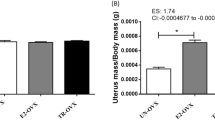Abstract
The effects of training and/or testosterone treatment and its aromatization to oestradiol on fatty-acid-binding protein (FABP) content and cytochrome c oxidase activity in heart, soleus and extensor digitorum longus (EDL) muscles were studied in intact adult female rats. One group of rats remained sedentary, whereas the others were trained for 7 weeks. Thereafter the trained rats were divided into control and testosterone-treated groups, with or without an aromatase inhibitor. Testosterone was administered by a silastic implant. Training was continued for 2 weeks. In untreated sedentary rats the immunochemically assayed FABP contents were 497±28, 255±49 and 58±17 μg/g wet weight for the heart, soleus, and EDL respectively. In the heart the FABP content was increased after training (29%), testosterone treatment (33%) or both manipulations (53%). In soleus muscle FABP increased only after testosterone treatment (16%), whereas in EDL no changes were found. Inhibiting the aromatase enzyme complex abolished the testosterone-induced effect on FABP content in soleus (suggesting an oestradiol effect) but not in heart muscle. Among the three muscles studied the FABP content was found to be related to the cytochrome c oxidase activity in a non-linear way. In conclusion, it is shown that the FABP contents and mitochondrial activities of heart and skeletal muscle are affected by training and sex hormones and that these effects are different for heart and skeletal muscles.
Similar content being viewed by others
References
Abernethy PJ, Thayer R, Taylor AW (1990) Acute and chronic responses to skeletal muscle to endurance and sprint exercise: a review. Sports Med 10:365–389
Bass NM (1988) The cellular fatty acid binding proteins. Aspects of structure, regulation, and function. Int Rev Cytol 111:143–184
Bass NM, Manning JA (1986) Tissue expression of three structurally different fatty acid-binding proteins from rat heart muscle, liver, and intestine. Biochem Biophys Res Commun 137:929–935
Bernard PA, Rance NE, Fishman PS, Max SR (1984) Increased cytosolic androgen receptor binding in rat striated muscle following denervation and disuse. J Neurochem 43:1479–1483
Beyer RE, Morales-Corral PG, Ramp BJ, Kreitman KR, Falzon MJ, Yung Shik Rhee S, Kuhn TW, Stein M, Rossenwasser MJ, Cartwright KJ (1984) Elevation of tissue coenzyme Q (ubiquinone) and cytochrome c oncentrations by endurance exercise in the rat. Arch Biochem Biophys 234:323–329
Dahlberg E (1982) Characterization of the cytosolic estrogen receptor in rat skeletal muscle. Biochim Biophys Acta 717:65–75
Galbo H (1981) Hormonal and metabolic adaption to exercise. Int J Sports Med 2:203–211
Glatz JFC, van der Vusse GJ (1989) Intracellular transport of lipids. Mol Cell Biochem 88:37–44
Glatz JFC, van der Vusse GJ (1990) Cellular fatty acid-binding proteins: current concepts and future directions. Mol Cell Biochem 98:237–251
Glatz JFC, Veerkamp JH (1985) Intracellular fatty acid-binding proteins. Review Int J Biochem 17:13–22
Glatz JFC, Baerwaldt CCF, Veerkamp JH, Kempen HJM (1984) Diurnal variation of cytosolic fatty acid-binding protein content and of palmitate oxidation in rat liver and heart. J Biol Chem 259:4295–4300
Glatz JFC, van der Vusse GJ, Veerkamp JH (1988) Fatty acid binding proteins and their physiological significance. News Physiol Sci 3:41–43
Gohil K, Jones DA, Edwards RHT (1981) Analysis of muscle mitochondrial function with techniques applicable to needle biopsy samples. Clin Physiol 1:195–207
Guzman A, Castro J (1988) Effects of endurance exercise on carnitine palmitoyltransferase 1 from rat heart, skeletal muscle and liver mitochondria. Biochim Biophys Acta 963:562–565
Koenig H, Goldstone A, Lu CY (1980) Androgens regulate mitochondrial cytochrome c oxidase and lysosomal hydrolases in mouse skeletal muscle. Biochem J 192:349–353
Linssen MCJG, York MM, de Jong YF, Glatz JFC, van der Vusse GJ (1990) Fatty acid oxidation capacity and fatty acid-binding protein content of different cell types isolated from rat heart. Mol Cell Biochem 98:19–25
Marcus KD, Tipton CM (1985) Exercise training and its effects with renal hypertensive rats. J Appl Physiol 59:1410–1415
Matsumine H, Hirato K, Yanaihara T, Tamada T, Yoshida M (1986) Aromatization by skeletal muscle. J Clin Endocrinol Metab 63:717–720
Meyer HH, Rapp M (1985) Estrogen receptors in bovine skeletal muscle. J Anim Sci 60:294–300
Michel G, Baulieu EE (1980) Androgen receptor in rat skeletal muscle: characterization and physiologiclal variations. Endocrinology 107:2088–2098
Miller WC, Hickson RC, Bass NM (1988) Fatty acid binding proteins in the three types of rat skeletal muscle. Proc Soc Exp Biol Med 189:183–188
Ockner RK, Lysenko N, Manning JA, Monroe SE, Burnett DA (1980) Sex steroid modulation of fatty acid utilization and fatty acid-binding protein concentration. J Clin Invest 65:1013–1023
Paulussen RJA, Geelen MJM, Beynen AC, Veerkamp JH (1989) Immunochemical quantitation of fatty acid-binding proteins. I. Tissue and intracellular distribution, postnatal development and influence to physiological conditions on rat heart and liver FABP. Biochem Biophys Acta 1001:201–209
Peeters RA, Veerkamp JH, Geurts van Kessel A, Kanda T, Ono T (1991) Cloning of the cDNA encoding human skeletal-muscle fatty acid-binding protein, its peptide sequence and chromosomal localization. Biochem J 276:203–207
Penpargkul S, Schwartz A, Scheuer J (1978) Effect of physical conditioning on cardiac mitochondrial function. J Appl Physiol 45:978–986
Stumpf WE (1990) Steroid hormones and the cardiovascular system: direct actions of estradiol, progesterone, testosterone, gluco- and mineral-corticoids, and soltriol (vitamin D) on central regulatory and peripheral tissues. Experientia 46:13–25
Wouters W, De Coster R, Krekels M, van Dun J, Beerens D, Haelterman C, Raeymaekers A, Freyne E, van Gelder J, Venet M, Janssen PAJ (1988) R 76713, a new specific non-steroidal aromatase inhibitor. J Steroid Biochem 32:781–788
Author information
Authors and Affiliations
Additional information
Established Investigator of the Netherlands Heart Foundation
Rights and permissions
About this article
Cite this article
van Breda, E., Keizer, H.A., Vork, M.M. et al. Modulation of fatty-acid-binding protein content of rat heart and skeletal muscle by endurance training and testosterone treatment. Pflügers Arch 421, 274–279 (1992). https://doi.org/10.1007/BF00374838
Received:
Revised:
Accepted:
Issue Date:
DOI: https://doi.org/10.1007/BF00374838




